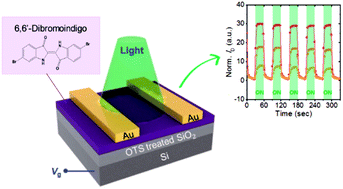Ambipolar organic phototransistors based on 6,6′-dibromoindigo†
Abstract
Ambipolar organic phototransistors were fabricated using a natural pigment 6,6′-dibromoindigo (6-BrIG) as the active channel. These phototransistors yielded significantly enhanced currents upon light illumination with photoresponsivities and external quantum efficiencies as high as 10.3 A W−1 and 2437% for the n-channel, and 55.4 mA W−1 and 13.1% for the p-channel, respectively. In addition, simple inverter complementary circuits were fabricated by integrating two ambipolar phototransistors. Channel current was dependent on light intensity and voltage bias. This study provides a basis for an in-depth understanding of the optoelectronic characteristics of 6-BrIG, and introduces this material as an ecofriendly candidate for optoelectronic applications.



 Please wait while we load your content...
Please wait while we load your content...